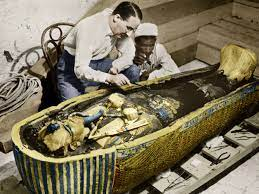Howard Carter, a British Egyptologist and his team began excavating the tomb of Tutankhamun in the Valley of the Kings, Egypt, on November 4, 1922. Tutankhamun, alias King Tut, was an Egyptian pharaoh who became ruler at nine years old in 1333 B.C until his death a decade later. Dying young explains why he only made a faint impression on ancient Egyptian history. According to Egyptian tradition, King Tut was mummified and buried in a tomb filled with jewelry, artwork, and treasures after his death. However, the tomb was quickly covered by shifting desert sands, hiding it for more than 3,000 years.
On November 4, 1922, Howard Carter, Lord Carnarvon and his entire team found the first step of a staircase leading to King Tutankhamen’s tomb. They found the sealed burial chambers miraculously intact, with a collection of several thousand priceless objects inside, for instance, the gold coffin containing the teenage king’s mummy.
Tutankhamen’s tomb was so hard to find because, in the 13th century B.C., king Tutankhamen and the other “Amarna” kings had been publicly condemned. Thus most records of them, including the location of King Tuts’ tomb, were destroyed. A century later, workers building a mausoleum for Ramses VI unintentionally covered Tutankhamen’s tomb with a deep layer of chips, further hiding it from any future discovery.
However, after World War 1, Carter began an intensive search for King Tutankhamen’s tomb until he finally found it. Finally, on November 26, 1922, they broke through the tomb’s door, and Carter said he saw wonderful things. Nonetheless, it was not until much later that they revealed the casket carrying Tutankhamen’s mummy.

